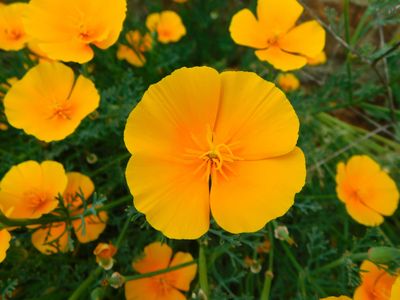Introduction
- Overview: Native wildflower, drought-tolerant, California's state flower.
- Why grow it: Low-maintenance, pollinator-friendly, beautiful golden-orange blooms.
Quick Facts
- Type: Perennial in our climate
- Height: 12-18 inches tall and wide
- Bloom Season: Late spring through early summer
- Sun Requirements: Full sun
- Water Needs: Low once established
- Soil Type: Well-draining, sandy or poor soil preferred
Planting Guide
When to Plant
- Fall: A great time to sow in our climate is around Halloween, or when the first rains are forecast. Seeds germinate with winter rains and you don't have to worry about staying on top of watering.
Where to Plant
- Full sun areas with well-draining soil.
- Avoid overly rich or moist soil — these encourage more foliage and fewer flowers.
How to Plant
- Direct sow seeds; avoid transplanting (poppies have a long taproot and don’t like being moved).
- Scatter seeds on bare soil and lightly press them in. Do not cover deeply — they need light to germinate!
- Water lightly until established if no rain.
Care & Maintenance
Watering
- Keep soil moist during germination (1–2 weeks).
- Once established, water sparingly. Too much water leads to leggy growth.
Fertilizing
- Not necessary — thrives in poor soil.
- Overfeeding reduces blooms.
Deadheading
- Optional: Removing spent blooms encourages more flowers and a tidier look.
- Allow some seed pods to develop for natural reseeding.
Pests & Problems
- Generally pest-free.
- Can suffer in overly rich or wet soil — root rot or damping-off in seedlings.
Lifecycle & Reseeding
- Self-seeds easily. Dies back in heat or after flowering, but new seedlings often appear the next season if seeds are left to drop.
- It’s also perennial in our climate, so instead of pulling it out after it flowers, you can cut it back to about 3" above the ground.
Wildlife & Companion Benefits
- Attracts bees, butterflies, and beneficial insects.
- Great in wildflower meadows, rock gardens, and xeriscapes.
Extra Tips
- Great for kids' gardens because they're easy and fast-growing.
- Combine with other natives like lupine, tidy tips, or desert bluebells, which all have similar growing conditions.
Where to Get Seeds
